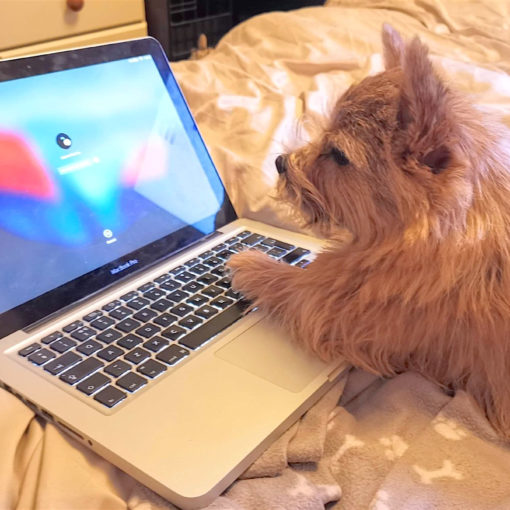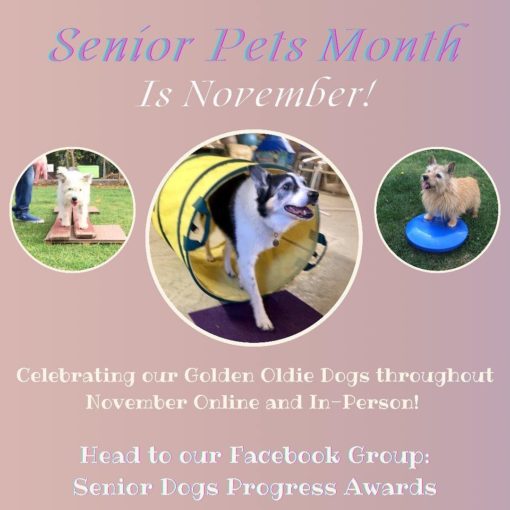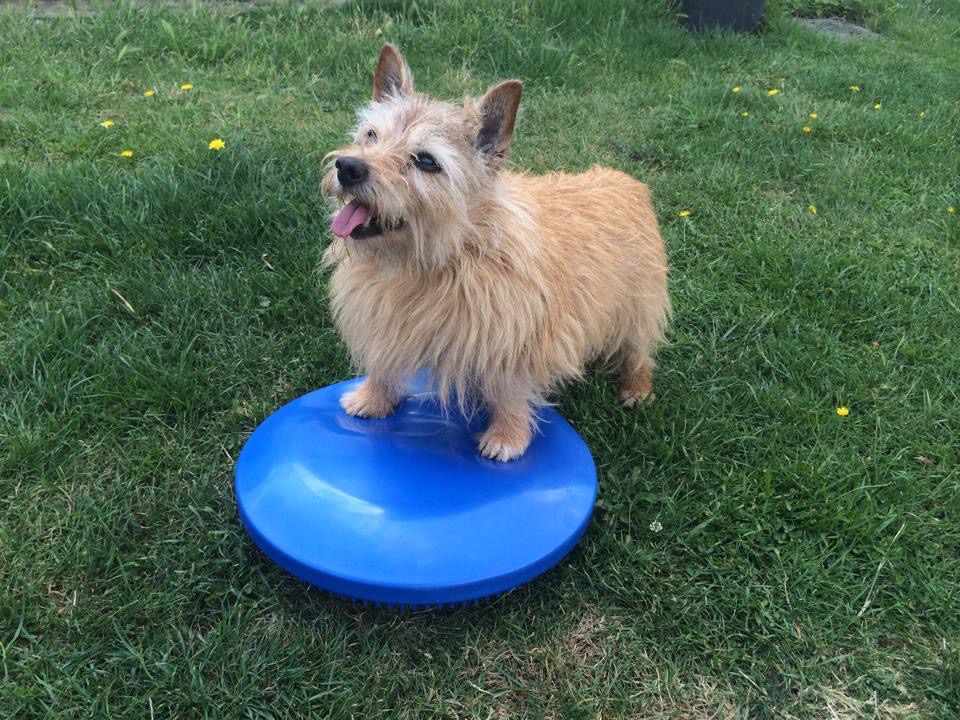
This week is Dementia Awareness Week so we are focusing on Canine Dementia – yes this is a real thing.
Also known as Canine Cognitive Dysfunction (CCD), dementia in dogs is something that can occur in dogs who are older.
Signs of Canine Dementia can include:
- Playing less or reluctance to play
- Becoming stuck behind furniture – as well as being confused they can loose body awareness so don’t know they can reverse
- Decreased stamina
- Staring at walls
- Standing in corners of the room and just waiting
- Responding less to commands
- Howling/barking at night
- Sleeping more during the day
- Seems confused or disoriented
- Having accidents in the house
- Change in eating habits
- Change in attitude
- Pacing or wandering aimlessly
- Abnormal interactions with owner or other pets inc misunderstanding calm body language and showing mild aggression through confusion
- A form of depression due to owners reducing their activity to protect a dog from injury if they are pacing or circling
Fitness and a Healthy Lifestyle for our dogs starts with ensuring they have enough mental stimulation. Giving dogs of all ages a chance to work out their brains helps with development as well as pushing back typical cognitive issues and there are many ways we can encourage our dogs to use their brains no matter what their age or breed type!
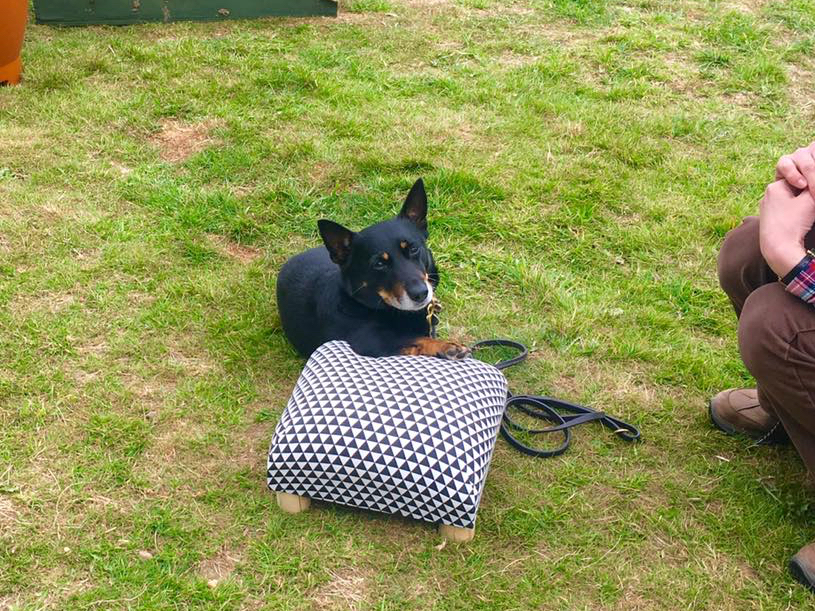
So let’s first look at the benefits of providing brain stimulation and challenging our dogs minds! Dogs have a natural working instinct, which is what separates the different breed groups as each group type have their own set of natural skills, although most dogs can do skills from other breed groups too! This natural urge to think and learn needs to be stimulated and when it’s not we start to see typical behaviours such as digging up the back garden, stealing laundry, chewing trainers etc. It’s not dogs purposely being naughty but more they are seeking a way to use their minds and then if we give lots of attention for it they are on to a winner!!
Now, brain fitness is very different to physical fitness. Walks are great for us and our dogs but it doesn’t mean their minds are being worn out: I can go for a long walk but come home and easily read a book as my mind hasn’t necessarily been stretched. Providing brain work for our dogs varies from dog to dog and can be started from young puppy and then continued through to late senior which prepares our dogs for becoming older.
Creating various types of brain work can help by providing your dog with these benefits:
- Developing learning abilities – in puppies and adult dogs the more they learn the better they get at it and can adapt and progress better in new situations such as when the body ages and they need to be more aware when stepping over something.
- Senior and adult dogs can actually benefit from brain stimulation with pushing back the onset of cognitive issues such as doggie dementia and the general aging process. Studies have shown that dogs who are learning and using their minds when older continue to learn and process information better and show reduced confusion or ‘older dog’ issues.
- Working with our dogs on mental challenges is a brilliant way to bond with our dogs and spend quality time together especially if we have more then one dog or lots of pets. Building these bonds help with our dogs overall focus, trust, and responsiveness to us for both at home and on walks but also the added bonus of increasing our dogs’ overall feelings of wellbeing which in turn helps prevent early onset cognitive issues.
What can we do to maintain our dogs’ brain health?!
There are a huge range of ways we can introduce mental challenges and here are some examples:
Interactive Toys:
Providing challenges for dogs to work our requires mental fitness and these challenges can include puzzle toys such as Nina Ottosson and Trixie toys that you put food inside as well as ‘find it’ toys where there are several smaller items inside a larger version for dogs to find and pull out! Navigating shapes to find something is great for brain work as well as utilising scent, sight etc and does discriminate mobile dogs from less active dogs.
Challenges – Physical as well as Mental:
Creating challenges for your dog to work out can be such fun and include things like mazes for you to help your dog navigate. This doesn’t need to be a full blown maze grown in your garden but can be just a couple of tunnels and pop up tents set up for your dog to follow with a treat or toy at the end or set up a couple of boards or boxes to make maze walls and encourage your dog to find their way through to something fun.
Mini courses using platforms and stools can be fun too and can be lower to prevent the risk of your dog falling off. Having a line of aerobic steps, decking boards, bath steps with small gaps between for your dog to walk along means they are needing to pay attention to the gaps to step over. It doesn’t have to be hugely physical but using their minds to work out where to place their feet, to balance etc is really great for continued cognitive skills, proprioception and keeping the brain signals reaching around the body!
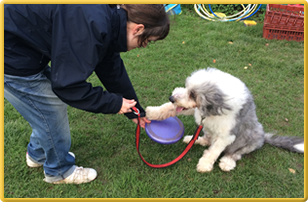
Training – In general:
Taking your dog to obedience classes or working on training at home will be utilising your dogs brain skills regularly. They are remembering hand cues and words, orders of movements etc.
You can increase your dogs training to bring in new exercises or tricks to learn as well as returning to foundation exercises but making them harder with adding some distance between you and your dog or doing them with reduced hand signals or asking for something with your back to your dog. These require your dog to think more about what they are being asked to do and encourage further learning.
All types of training are great for utilising your dogs thinking and learning abilities, whether it’s obedience, agility, tricks, scent … Always consider your dogs own abilities and needs as there are so many activities available both as in person classes and online. Scentwork comes in many forms and really utilises a dogs mind which results in tired dogs later that day! Tricks are fully matched to each dog and provide brain workouts as dogs think about which paw to use, how to balance etc. Agility and Hoopers are more physical but don’t have to be fast or too hard as they provide mental challenges for dogs to navigate the equipment.
Training – Working on activities specifically aimed at expanding the mind such as Memory Training or Cognitive Skills Training.
I love teaching these types of workshops and seeing dogs really thinking and working out what is happening, then the change in body language when they get it right and receive praise!
Memory Training is a brilliant type of dog training created by Kay Atwood which involves an initial protocol to help dogs start thinking about what they are looking at and to apply logic – using shapes printed onto paper dogs can actually learn to indicate which matches the shape their owner is holding, or progress to size and even numbers! This of course really gets a dogs mind working hard and is fun for dogs while not being challenging physically.
Do As I Do training created by Claudia Fuzzila applies a new protocol to help dogs learn through mimicry instead of being guided or lured into position etc. Dogs get to work their minds via focusing and imitating their owners which gives them a great brain workout and the exercises can progress in difficulty but can remain at each dogs physical level.
Scentwork comes in many formats and really works the brain so is great for helping to tire out busy dogs! Scentwork includes search and find (toys, treats etc), nosework (learning to locate a scent for a reward), tracking (leading their handler to follow a laid scent while on harness and lead) and even interiors Scentwork (learning to search a whole room or vehicle to find something hidden).
You can work with official Scentwork trainers for different types of Scent training as well as creating search and find games at home. Tracking is also used in Working Trials and I loved doing this with my Terrier, Taylor and he started this around age 7 until he was 11! What is great with Scentwork is dogs of any age can take part, any ability, any training level and handlers don’t need to be able to run fast, drag equipment about or have huge amounts of land which makes it accessible as an activity for more people and their dogs.
Did you know there are Senior Dogs Progress Awards running online?! These have going for several years and are aimed at giving owners some ideas to work on with their older dog in a range of categories including Target Training, Item Interaction, Fitness and Strengthening and more. There are two levels for dogs over 7 years and another two aimed at dogs over 10 years and on passing dogs are awarded a special giant rosette too!! Take a look at: https://www.facebook.com/groups/1670155699890146/
Tricks Training:
Problem Solving Tricks such as remembering which cup a treat is under when several cups are upturned or which hand holds the treat are great foundations in brain work. They are easy for us to set up and easy for dogs to learn. These can progress to Tricks such as retrieve a treat where a treat is inside a small pot with string attached and pushed under something too low for a dog to squeeze under so they learn to pull the string to retrieve the pot with the treat. Problem solving at a higher level indeed!

There’s even fitness for dogs such as actual Canine Conditioning and also Wag and Tone for owners and dogs to do together! These types of activities are more physically involved but also require focus and understanding from the dogs as they work out how to balance, manoeuvre and complete exercises using various types of equipment. Using Cavaletti dogs are assessing how high to lift each foot, or for sit to stand on a rocker board they are focusing on weight shifting and balance so the mind is getting its own workout too!
Mental well-being isn’t always just training but can be spending quality time with our dogs:
Meandering and Stimulating Walks! Even if your dog cannot go on long adventurous walks following illness, being too young or ageing joints it doesn’t mean they don’t enjoy walks and exercise of some kind. Consider what your dog may like during a walk-exercise, smells, interaction with people, interaction with dogs, marking plants, stopping at a cafe for a drink with you?
You can shorten or adapt your walks to focus on your dogs needs and likes and still provide your dog’s favourite areas of enrichment! So if your dog loves to mooch about and sniff, maybe drive to the park so there’s less stress on the body during a road walk and go stand with your dog to let them sniff about for 15 mins. If the exercise isn’t their favourite part, then adjust the walk to keep it fun for them! If your dogs loves to meet people and is happy to sit and be fussed then take them to places you know there will be people who like dogs-maybe visit family or neighbours who are lonely but love dogs, invite friends on your walks who love your dog. It might be a shorter walk now but the attention during that walk will be amazing for your dog!
Even time in the garden or yard with your dog – whether they are charging about and playing or they need a little help to get around – going out in the garden provides even more quality time with you without distractions, allows you to keep an eye on your dog, and means they might spend more time investigating, sniffing, seeing, hearing. Did they used to like to check the far corner of the garden but haven’t for a while because there’s garden furniture in the way? Move the furniture a little and guide your dog over for a sniff. Even just once a week gives your dog something to enjoy!
Maybe they can’t get up and down steps so well as too young for steps or have had recent surgery they are recovering from. Look at creating a ramp or moving things closer if possible. Ramps can be purchased and fitted specifically, or a car ramp you put in place yourself, or even create a ramp with materials. If a ramp isn’t possible maybe look at adding a concrete slab to create a step up to the back door or extra, smaller steps to the usual higher steps. Not only is this helping your dog have some freedom but also independence for brain activity and for body condition of all ages.
Socialising – for Senior Dogs?!
When I run a puppy adventures session it’s about positive experiences for the puppies and everything new is brain work while they take in what is in front of them, figure out what to do etc. Some fun examples can be a small pop up tunnel, ball pool with hidden treats or toys, sand pit with actual sand or a trip to the beach, creating a sensory cube which is a frame the puppy can walk through with items hanging down such as strips of felt and paper chains, string with soft toys, a light blanket. These experiences are perfect to do with our Senior dogs too as they really help dogs engage the brain to problem solve etc!
Senior Dogs – cognitive workouts:
As dogs age, which varies for different breed types, we can often see they slow down in their thinking. Unfortunately so often this is accepted as just old age and the memory and learning abilities are left to dwindle. Humans do all kinds of brain games to help keep their minds active while growing old including sudoku, brain games on computer, reading, crosswords etc and in a way we can do the same for our older dogs too.
You can start any time but if your dog has started showing their age and as forgotten some old tricks or seems more confused we can kick start the mind into working better again using all kinds of dog puzzles!
There are a host of treat balls / treat rollers, and toys as mentioned before. When used for general brain motivation instead of trying to tire your dog out the puzzles don’t need to be hard, but should be achievable! One of Cassie’s favourites at age 16 1/2 while deaf, a little less steady on her back legs and forgetting what she was doing at times was a Trixie treat roller. Literally a tube with holes around it and some plastic obstacles inside so the treats could fall out immediately and Cassie just needed to roll it with her nose or forehead or even a paw. She would push it and run after it happily while collecting treats and I loved watching her find it again and prepare to push it as she always liked to push toys as hard as possible across the room lol!!
Reteaching basics might seem boring to us but it gives you and your older dog some extra valuable time together, doesn’t need to take long and achieving criteria is quicker and easier which boosts motivation and learning. Teaching tricks like a nose touch to hand or chin target are great fun and are teamwork plus can be done while your dog sits or lays if needed. Teaching to step over a couple of small flat poles works the brain to feet connections as dogs are working out how to navigate the items for a reward so can help focus and brain work as well as body awareness, balance and even help the signals through the nerves continue to work properly which leads to continued mobility. Even tricks such as rolling out a mat really help keep the mind working hard and also happens to encourage movement in the neck and legs too x
Nutrition!
I’m not a canine nutritionist and am not going to pretend I am, however all the years of researching for my own Senior dogs as well as seeing results of trying various foods and supplements has helped me to identify some additional ways we could potentially be helping our older dogs not rush towards Cognitive Dysfunction. There are foods safe for dogs that are known for their brain boosting such as:
Blueberries
Spinich
Sweet Potato
Coconut Oil – scientifically proven to aid brain function!
Fish and Fish Oil such as Salmon, Sardines and Tuna
You can add one or two of these to your dogs meals a few times a week to help give your dogs brain a good boost!
There are also supplements created especially for Senior dogs with ingredients that help towards a healthy mind to prevent or slow down the onset of canine cognitive issues. They vary in ingredients, how regularly they are taken with regards to slow or regular release of nutrients and can have varied results but it can be worth looking into these if you notice your dog showing any signs of dementia and your vet has confirmed this may be the case. One I used with Cassie and found the company to be really helpful when I was researching is Logic Senilife by Ceva. I found after a few weeks of these Cassie was more alert and keen to do activities for longer – not necessarily physical but could focus for longer. Sadly this is no longer being produced so I am in the process of researching for a substitute to recommend if needed.
More types of supplement that have been known to help dogs with dementia include:
SAMe
Denamarin
Vitamin E
Omega 3 Fatty Acids
Soliquin
There are also options vets can prescribe once they have seen your dog and diagnosed Canine Cognitive Dysfunction.
Brainwork, stimulation, mind training etc is something we can all do with our dogs to help keep their cognitive processes and skills functioning well, while also helping reduce cognitive dysfunction and dementia issues too.
There are so many ways to provide your dogs mind with challenges to stay fit and healthy it’s fun to find out what you and your dog both enjoy doing together! Try something and if it’s not for you move on to something else but most importantly have fun with your dog!!
Joe Nutkins,
Certified Professional Canine Fitness Trainer
Kennel Club Accredited Instructor
CAM Level 1 Cambassador
Certified Trick Dog Instructor
Accredited Canine Hoopers UK Instructor

fitness training into double figures!


